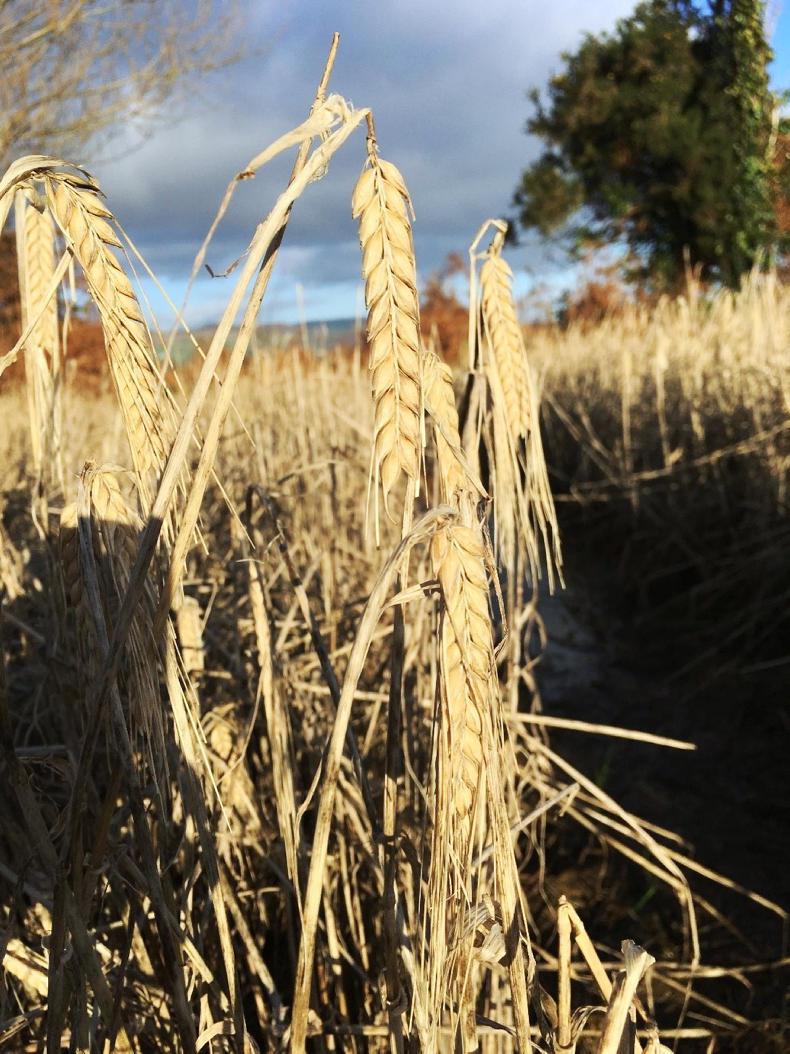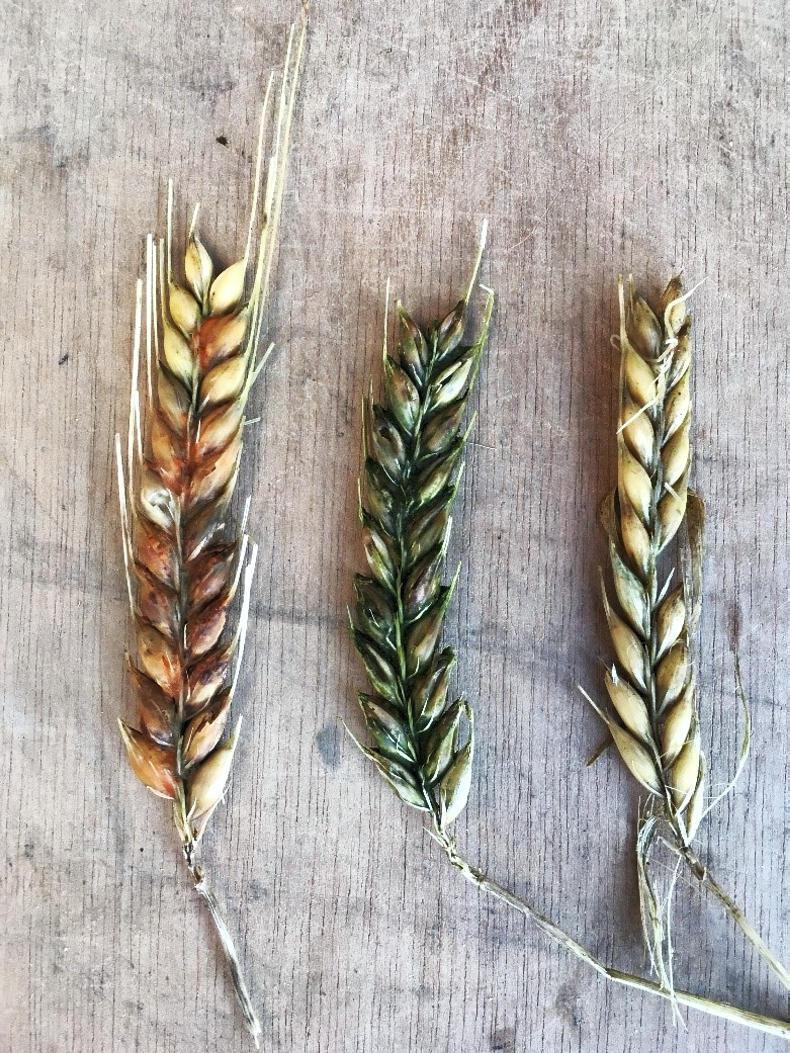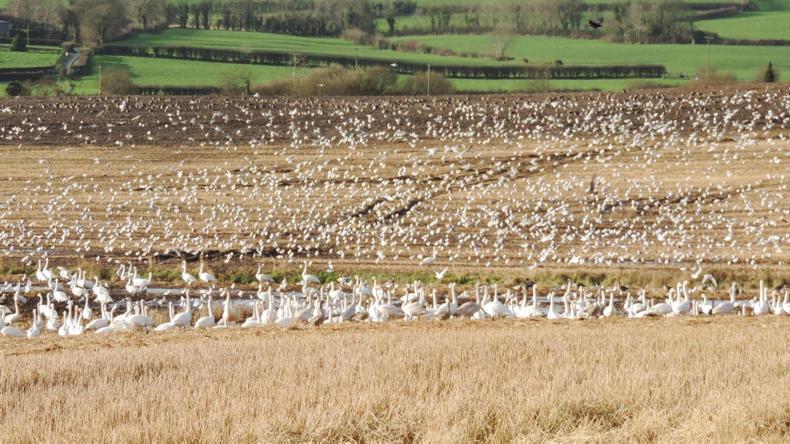Once again some growers find themselves facing into a new year recovering from the effects of an incredibly challenging harvest.
Thousands of acres of straw remain to be saved and, for a select number of farmers who were unable to complete their harvest in 2017, decisions must now be made about how to deal with what remains of their crops (mostly spring cereals).
Although the adverse weather during last harvest was not just confined to farms along the western seaboard, once again they were the ones who experienced the worst of it. Speaking to growers who lost crops in the region, their individual unharvested acreage ranged anywhere between 10 and 90 acres. An estimated 5% of crops area was not harvested in Northern Ireland.
It goes without saying that, where possible, farmers should try to capture any value from these crops as a means to offset losses, especially in the absence of a crop loss scheme. How this can be achieved must be determined on a field-by-field basis.
Condition of the crop
Crop still standing: If the crop is still standing, has brackled or has lodged but the head remains off the ground, then there is still scope for harvesting the grain. Many of the grains have not germinated due to poor weather so these will most likely go through the combine with ease if weather conditions improve.
Crop has lodged: Crops which have severely lodged are most likely beyond the point of being safe to salvage. Grains which have been soaked at ground level during the wet autumn and winter have high levels of fusarium, sooty moulds and rots or have been eaten by slugs, mice and other field pests. In those circumstance, grain should not salvaged and incorporation may be the best way to recover any value.
Crops have been grazed: Crops in the northwest in particular have been heavily grazed by whooper swans, greylag geese, crows and pigeons. Thousands of birds have wintered well on these fields and have trampled much of the remaining crop. Whatever grain is left on the crop is beyond the point of salvage and the straw may contain large concentrations of bird droppings. Incorporation may be the best way to recover any value.

Standing crops are worth attempting to harvest when the weather improves in spring.
Management options for the crop
Harvest the crop: Depending on weather conditions, crops which are still standing or brackled may still be worth attempting to harvest later in the spring. In some cases, this could mean harvesting the entire field or just a portion of it. Many seeds have not yet germinated but those which have, or those which have high levels of moulds or rots, should not be harvested as they may not be usable and may only cause problems in storage.
Baling the crop: Crops which aren’t lying flat on the ground may be worth mowing and baling for straw when the weather improves. Bear in mind that the same principles of grain quality apply for baling as they do for harvesting. However, there are also thousands of acres of straw waiting to be baled so just because this market is strong for the moment doesn’t necessarily mean the demand will be there later in spring when you may be able to bale it.
Grazing: Where crops have lodged and germinated, there may be potential for grazing by sheep or other stock. Germination changes the nutrient composition of grains. In barley, for example, it causes an overall reduction in dry matter and total energy but increases protein concentration as well as fibre and vitamin content.
Farmers who lost crops in 2016 and grazed sheep on them in the autumn and following spring stated that, while the stock did not thrive on the germinated crops, they trampled and broke down the straw which made it easier to incorporate in spring.
Where grains have not germinated and are free from moulds and rots there should be no problem grazing them. Depending on the condition of the crop, utilisation may be low but strip-grazing could help improve this.
Incorporation: For many, incorporation may be the only option left. While the benefits may not be available for a number of years, there is nutrient and structural value from returning the entire crop to the ground.
Where min-till or direct-drill systems are used, the volume of surface material will make it difficult to carry out field operations. Ploughing down what’s left on the surface is the best option to clear the field for the following crop.
In general, with the exception of a few intensely grazed or flooded fields, crops will need some form of encouragement to help break down the straw before ploughing.
When the crop is dry, the straw will be brittle and a number of passes from cultivation equipment such as a disk harrow should chop the straw enough to make it easier to fully invert and decompose.
The angle of the disks must be set as close to vertical as possible as the aim of this exercise is to cut the straw and not to tear up the soil. Run the disks at a 90° angle to the direction of the lodging.
A number of passes with a straw rake might also help and some farmers even suggested mowing or topping the crops to help break up the straw as much as possible.
Fields must be ploughed well to bury all surface trash. Don’t be surprised if you plough up black straw next year as straw may be slow to decompose on worn tillage ground.

Grain quality varies significantly depending on whether the crop was standing or laying.
Plough adjustments
If you have trouble ploughing down large volumes of surface trash, there are a number of adjustments which you can make to help with this.
Plough deeper: Plough to at least depths of 8in (20.3cm) or more.Widen plough: If possible, adjust the width of your furrows to between 16-18in (41-46cm).Plough slower: Ploughing slower will help ensure full inversion of the soil.Lower skimmers: If present, lowering skimmers to make them slightly deeper will assist in burying trash. Remove disks: If your plough has disks and they are dragging trash, take all but the last one off. Potential problems to look out for
While many of the growers who lost crops in the 2016 harvest stated that they had no significant knock-on effects in the following year, there are a number of potential problems to watch out for.
Nitrogen lock-up: If straw is being incorporated for the first time into long-term tillage ground, this can cause a decrease or “lock-up” of soil N as the decomposition of the carbon-rich straw causes soil microbes to take available nitrate or ammonium N from of the soil. This could potentially rob a portion of N required by spring seedlings. Depending on the growing season, soil health and level of microbial activity, an additional 15-20kg/N/ha (12-16 units/ac) may be needed in order to compensate for this.
Hold off until the last opportunity in the growing season to do this however, as it may not be necessary.
Volunteers: Many grains have not germinated this year despite the relatively mild temperatures. However, these may still germinate when they become mixed with soil. A stale seed bed after disking and clean deep ploughing should help reduce the population of volunteers.Disease carry-over: Crops which are heavily infected with fusarium and other fungal pathogens will most likely be incorporated back into the soil. Therefore, the likelihood of infection of the next crop by soil-borne fungal pathogens increases significantly, so seed-dressing is essential. Increased pests: With the relatively mild winter, where evidence of slugs attacking lodged grain is present, there is a likelihood of higher-than-average slug populations. Spring cultivations will help dry out any eggs but be extra vigilant towards slug damage at the start of the growing season. There may also be higher than normal numbers of rodents around due to the abundance of food. Hundreds of acres of cereal crops were not cut across the northern side of the country in 2017.The condition of those crops now ranges from standing with apparent good quality grain to severely lodged with very poor quality grain and straw. Farmers must decide on whether to try to harvest, bale, graze or incorporate their remaining crops.There are a number of potential problems which farmers must look out for in the coming years in fields where the crop or the straw were not removed in 2017.
Once again some growers find themselves facing into a new year recovering from the effects of an incredibly challenging harvest.
Thousands of acres of straw remain to be saved and, for a select number of farmers who were unable to complete their harvest in 2017, decisions must now be made about how to deal with what remains of their crops (mostly spring cereals).
Although the adverse weather during last harvest was not just confined to farms along the western seaboard, once again they were the ones who experienced the worst of it. Speaking to growers who lost crops in the region, their individual unharvested acreage ranged anywhere between 10 and 90 acres. An estimated 5% of crops area was not harvested in Northern Ireland.
It goes without saying that, where possible, farmers should try to capture any value from these crops as a means to offset losses, especially in the absence of a crop loss scheme. How this can be achieved must be determined on a field-by-field basis.
Condition of the crop
Crop still standing: If the crop is still standing, has brackled or has lodged but the head remains off the ground, then there is still scope for harvesting the grain. Many of the grains have not germinated due to poor weather so these will most likely go through the combine with ease if weather conditions improve.
Crop has lodged: Crops which have severely lodged are most likely beyond the point of being safe to salvage. Grains which have been soaked at ground level during the wet autumn and winter have high levels of fusarium, sooty moulds and rots or have been eaten by slugs, mice and other field pests. In those circumstance, grain should not salvaged and incorporation may be the best way to recover any value.
Crops have been grazed: Crops in the northwest in particular have been heavily grazed by whooper swans, greylag geese, crows and pigeons. Thousands of birds have wintered well on these fields and have trampled much of the remaining crop. Whatever grain is left on the crop is beyond the point of salvage and the straw may contain large concentrations of bird droppings. Incorporation may be the best way to recover any value.

Standing crops are worth attempting to harvest when the weather improves in spring.
Management options for the crop
Harvest the crop: Depending on weather conditions, crops which are still standing or brackled may still be worth attempting to harvest later in the spring. In some cases, this could mean harvesting the entire field or just a portion of it. Many seeds have not yet germinated but those which have, or those which have high levels of moulds or rots, should not be harvested as they may not be usable and may only cause problems in storage.
Baling the crop: Crops which aren’t lying flat on the ground may be worth mowing and baling for straw when the weather improves. Bear in mind that the same principles of grain quality apply for baling as they do for harvesting. However, there are also thousands of acres of straw waiting to be baled so just because this market is strong for the moment doesn’t necessarily mean the demand will be there later in spring when you may be able to bale it.
Grazing: Where crops have lodged and germinated, there may be potential for grazing by sheep or other stock. Germination changes the nutrient composition of grains. In barley, for example, it causes an overall reduction in dry matter and total energy but increases protein concentration as well as fibre and vitamin content.
Farmers who lost crops in 2016 and grazed sheep on them in the autumn and following spring stated that, while the stock did not thrive on the germinated crops, they trampled and broke down the straw which made it easier to incorporate in spring.
Where grains have not germinated and are free from moulds and rots there should be no problem grazing them. Depending on the condition of the crop, utilisation may be low but strip-grazing could help improve this.
Incorporation: For many, incorporation may be the only option left. While the benefits may not be available for a number of years, there is nutrient and structural value from returning the entire crop to the ground.
Where min-till or direct-drill systems are used, the volume of surface material will make it difficult to carry out field operations. Ploughing down what’s left on the surface is the best option to clear the field for the following crop.
In general, with the exception of a few intensely grazed or flooded fields, crops will need some form of encouragement to help break down the straw before ploughing.
When the crop is dry, the straw will be brittle and a number of passes from cultivation equipment such as a disk harrow should chop the straw enough to make it easier to fully invert and decompose.
The angle of the disks must be set as close to vertical as possible as the aim of this exercise is to cut the straw and not to tear up the soil. Run the disks at a 90° angle to the direction of the lodging.
A number of passes with a straw rake might also help and some farmers even suggested mowing or topping the crops to help break up the straw as much as possible.
Fields must be ploughed well to bury all surface trash. Don’t be surprised if you plough up black straw next year as straw may be slow to decompose on worn tillage ground.

Grain quality varies significantly depending on whether the crop was standing or laying.
Plough adjustments
If you have trouble ploughing down large volumes of surface trash, there are a number of adjustments which you can make to help with this.
Plough deeper: Plough to at least depths of 8in (20.3cm) or more.Widen plough: If possible, adjust the width of your furrows to between 16-18in (41-46cm).Plough slower: Ploughing slower will help ensure full inversion of the soil.Lower skimmers: If present, lowering skimmers to make them slightly deeper will assist in burying trash. Remove disks: If your plough has disks and they are dragging trash, take all but the last one off. Potential problems to look out for
While many of the growers who lost crops in the 2016 harvest stated that they had no significant knock-on effects in the following year, there are a number of potential problems to watch out for.
Nitrogen lock-up: If straw is being incorporated for the first time into long-term tillage ground, this can cause a decrease or “lock-up” of soil N as the decomposition of the carbon-rich straw causes soil microbes to take available nitrate or ammonium N from of the soil. This could potentially rob a portion of N required by spring seedlings. Depending on the growing season, soil health and level of microbial activity, an additional 15-20kg/N/ha (12-16 units/ac) may be needed in order to compensate for this.
Hold off until the last opportunity in the growing season to do this however, as it may not be necessary.
Volunteers: Many grains have not germinated this year despite the relatively mild temperatures. However, these may still germinate when they become mixed with soil. A stale seed bed after disking and clean deep ploughing should help reduce the population of volunteers.Disease carry-over: Crops which are heavily infected with fusarium and other fungal pathogens will most likely be incorporated back into the soil. Therefore, the likelihood of infection of the next crop by soil-borne fungal pathogens increases significantly, so seed-dressing is essential. Increased pests: With the relatively mild winter, where evidence of slugs attacking lodged grain is present, there is a likelihood of higher-than-average slug populations. Spring cultivations will help dry out any eggs but be extra vigilant towards slug damage at the start of the growing season. There may also be higher than normal numbers of rodents around due to the abundance of food. Hundreds of acres of cereal crops were not cut across the northern side of the country in 2017.The condition of those crops now ranges from standing with apparent good quality grain to severely lodged with very poor quality grain and straw. Farmers must decide on whether to try to harvest, bale, graze or incorporate their remaining crops.There are a number of potential problems which farmers must look out for in the coming years in fields where the crop or the straw were not removed in 2017. 







 This is a subscriber-only article
This is a subscriber-only article
















SHARING OPTIONS: